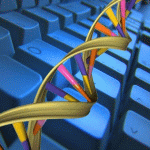Bioinformatics
|
17 april 2014 16:04:19 |
| Why is the biological hydrophobicity scale more accurate than earlier experimental hydrophobicity scales? (Proteins: Structure, Function, and Bioinformatics) |
|
Tweet The recognition of transmembrane helices by the translocon is primarily guided by the average hydrophobicity of the potential transmembrane helix. However, the exact hydrophobicity of each amino acid can be identified in several different ways. The free energy of transfer for amino acid analogues between a hydrophobic media, e.g. octanol, and water can be measured or obtained from simulations, the hydrophobicity can also be estimated by statistical properties from known transmembrane segments and finally the contribution of each amino acid type for the probability of translocon recognition has recently been measured directly. Although these scales correlate quite well, there are clear differences between them and it is not well understood which scale represents neither the biology best nor what the differences are. Here, we try to provide some answers to this by studying the ability of different scales to recognize transmembrane helices and predict the topology of transmembrane proteins. From this analysis it is clear that the biological hydrophobicity scale as well scales created from statistical analysis of membrane helices perform better than earlier experimental scales, that are mainly based on measurements of amino acid analogs and not directly on transmembrane helix recognition. Using these results we identified the properties of the scales that perform better than other scales. We find, for instance, that the better performing scales consider Proline more hydrophilic. This show that transmembrane recognition is not only governed by pure hydrophobicity but also by the helix preferences for amino acids, as Proline is a strong helix breaker. © Proteins 2014;. © 2014 Wiley Periodicals, Inc. |
| 102 viewsCategory: Biochemistry, Bioinformatics |
 Structural studies of bovine, equine, and leporine serum albumin complexes with naproxen (Proteins: Structure, Function, and Bioinformatics) Structural studies of bovine, equine, and leporine serum albumin complexes with naproxen (Proteins: Structure, Function, and Bioinformatics)Importance of polarization effect in the study of metalloproteins: Application of polarized protein specific charge scheme in predicting the reduction potential of azurin (Proteins: Structure, Function, and Bioinformatics) 
|
| blog comments powered by Disqus |
MyJournals.org
The latest issues of all your favorite science journals on one page
The latest issues of all your favorite science journals on one page



